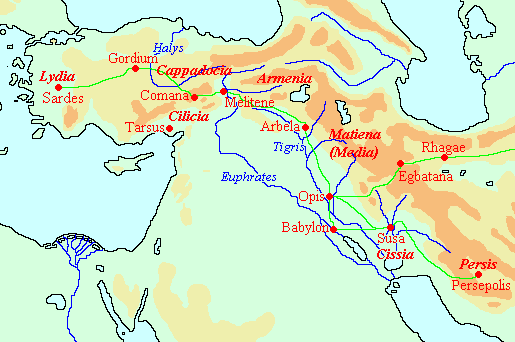Chapter13 |
Reading |
The Persian Courier Post

The Persian Royal Road stretched from Sardis in the west all the way to Susa and Persepolis
Having conquered numerous nations, one of Cyrus' greatest challenges was to organize this great empire and develop an administrative center at Persepolis. Cyrus' ingenious response was to leave the existing administration of each land in place. So he divided the empire into twenty-three provinces and sent a governor, called a satrap ("protector of the realm"), to each conquered nation. The satrap ruled each satrapy as the king's representative, ensconced in a palace set near a hunting park (paradeisos). In Persepolis, the royal archive of tablets provided records of the incoming and outgoing goods, grains, livestock, and seals stamped on documents indicated who authorized a particular transaction.
One of the ways that the far-flung Persian empire linked different ethnoi was through the creation of an extensive imperial road system. The Great King took advantage of this network of roads through the development of a postal system that helped him stay in touch with each satrapy. In this passage describing the Persian courier post from Herodotus, we learn more about the remarkable way that the Achaemenid kings kept in close contact with each satrapy throughout the empire. If each stage was about thirty kilometers, then it is estimated to take ninety days to travel from Sardis to Susa. Herodotus describes the royal road in more detail in Book 5.52-53. This road network became the basis for the later Silk Road opened during the Parthian period.
Photo credit: Jona Lendering, livius.org